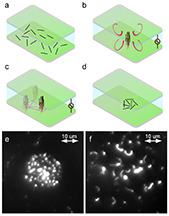April 20, 2016
System creates on-demand 'nanotube forests,' has potential industry applications
 |
|
This graphic illustrates a system that uses a laser and electrical field to precisely position and align carbon nanotubes, representing a potential new tool for assembling sensors and devices out of the tiny nanotubes and nanowires. The two microscope images at the bottom show the nanotubes aligned (left) and returning to their random orientation after the electric field and laser were turned off. (Purdue University image/Avanish Mishra and Steven Wereley) |
WEST LAFAYETTE, Ind. — A system that uses a laser and electrical current to precisely position and align carbon nanotubes represents a potential new tool for creating electronic devices out of the tiny fibers.
Because carbon nanotubes have unique thermal and electrical properties, they may have future applications in electronic cooling and as devices in microchips, sensors and circuits. Being able to orient the carbon nanotubes in the same direction and precisely position them could allow these nanostructures to be used in such applications.
However, it is difficult to manipulate something so small that thousands of them would fit within the diameter of a single strand of hair, said Steven T. Wereley, a professor of mechanical engineering at Purdue University.
"One of the things we can do with this technique is assemble carbon nanotubes, put them where we want and make them into complicated structures," he said.
New findings from research led by Purdue doctoral student Avanish Mishra are detailed in a paper that has appeared online March 24 in the journal Microsystems and Nanoengineering, published by the Nature Publishing Group.
The technique, called rapid electrokinetic patterning (REP), uses two parallel electrodes made of indium tin oxide, a transparent and electrically conductive material. The nanotubes are arranged randomly while suspended in deionized water. Applying an electric field causes them to orient vertically. Then an infrared laser heats the fluid, producing a doughnut-shaped vortex of circulating liquid between the two electrodes. This vortex enables the researchers to move the nanotubes and reposition them.
"When we apply the electric field, they are immediately oriented vertically, and then when we apply the laser, it starts a vortex, that sweeps them into little nanotube forests," Wereley said.
The research paper was authored by Mishra; Purdue graduate student Katherine Clayton; University of Louisville student Vanessa Velasco; Stuart J. Williams, an assistant professor of mechanical engineering at the University of Louisville and director of the Integrated Microfluidic Systems Laboratory; and Wereley. Williams is a former doctoral student at Purdue.
The technique overcomes limitations of other methods for manipulating particles measured on the scale of nanometers, or billionths of a meter. In this study, the procedure was used for multiwalled carbon nanotubes, which are rolled-up ultrathin sheets of carbon called graphene. However, according to the researchers, using this technique other nanoparticles such as nanowires and nanorods can be similarly positioned and fixed in vertical orientation.
The researchers have received a U.S. patent on the system.
The experimental work was performed at the Birck Nanotechnology Center in Purdue's Discovery Park. Future research will explore using the technique to create devices.
Writer: Emil Venere, 765-494-4709, venere@purdue.edu
Sources: Steven T. Wereley, 765-494-5624, wereley@purdue.edu
Note to Journalists: The research paper is available at http://www.nature.com/articles/micronano20165 or by contacting Emil Venere, 765-494-4709, venere@purdue.edu. The doi is:10.1038/micronano.2016.5
ABSTRACT
Dynamic optoelectric trapping and deposition of multiwalled carbon nanotubes
Avanish Mishra1, Katherine Clayton1, Vanessa Velasco2, Stuart J. Williams2 and Steven T. Wereley1
1Birck Nanotechnology Center, School of Mechanical Engineering, Purdue University, West Lafayette, IN 47907, USA and 2Department of Mechanical Engineering, University of Louisville, KY 40292, USA.
Correspondence: Steven T. Wereley (wereley@purdue.edu)
In the path toward the realization of carbon nanotube (CNT)-driven electronics and sensors, the ability to precisely position CNTs at well-defined locations remains a significant roadblock. Highly complex CNT-based bottom–up structures can be synthesized if there is a method to accurately trap and place these nanotubes. In this study, we demonstrate that the rapid electrokinetic patterning (REP) technique can accomplish these tasks. By using laser-induced alternating current (AC) electrothermal flow and particle–electrode forces, REP can collect and maneuver a wide range of vertically aligned multiwalled CNTs (from a single nanotube to over 100 nanotubes) on an electrode surface. In addition, these trapped nanotubes can be electrophoretically deposited at any desired location onto the electrode surface. Apart from active control of the position of these deposited nanotubes, the number of CNTs in a REP trap can also be dynamically tuned by changing the AC frequency or by adjusting the concentration of the dispersed nanotubes. On the basis of a calculation of the stiffness of the REP trap, we found an upper limit of the manipulation speed, beyond which CNTs fall out of the REP trap. This peak manipulation speed is found to be dependent on the electrothermal flow velocity, which can be varied by changing the strength of the AC electric field.

